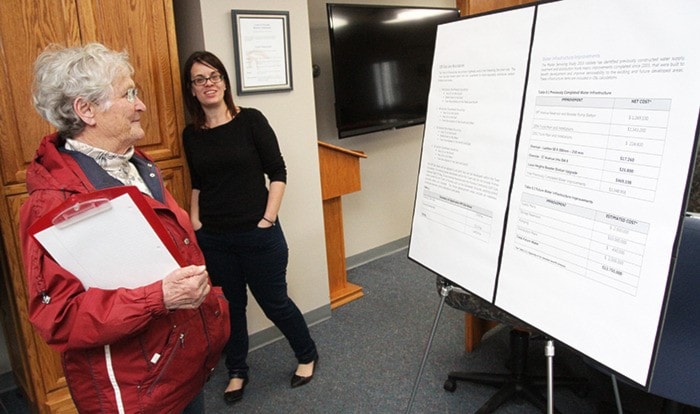Developers could be looking at increased costs to their projects if town council approves recommended off-site levy fees, considered to be high as compared to neighbouring municipalities.
The last time the Town of Ponoka’s off-site levies bylaw was updated was in 1978 for water and sanitary sewer and 1987 for storm sewer infrastructure in the Riverside area, despite a recommended review every year.
To bring these levies up to date, town administration hosted an open house Tuesday, March 31 at Town Hall, to give developers a chance to share their thoughts.
One question raised during the open house was why off-site levies were not updated on a regular basis as recommended.
What is an off-site levy?
As a town grows, municipalities are having to find ways to pay for infrastructure growth such as sanitary sewer treatment, water and storm infrastructure. Since those municipalities are responsible for that infrastructure, the cost to develop or improve them falls on the taxpayer.
An off-site levy puts the cost on the developers, who forward that cost to the buyers. This takes some financial pressure off existing residents, explained engineer Jim Duckworth with Tagish Engineering. Tagish was hired to provide recommendations to the town’s off-site levies. He says the basic premise of the levies is “existing residents don’t pay for new infrastructure.”
Current levies
The current bylaw provides these costs per hectare to developers:
- Residential, $9,671
- Industrial (6,000 square feet), $5,871
- Industrial (12,000 square feet), $8,871
Proposed levies show quite a jump, but Duckworth says the new recommended rates are based on projects from the last 10 years. Tagish’s proposal separates the town into four areas and covers water, sanitary sewer, storm and transportation.
- Northwest sector, $48,996
- Southwest sector, $45,244
- Southeast sector, $44,744
- Northeast sector, $42,391
Developer Grant Jorgensen praised the town and council for being proactive but the jump in offsite levies appeared daunting. “That’s a tough pill to swallow,” said Jorgensen.
When compared to other towns, Jorgensen suggested it was high. The City of Lacombe’s most recent 2013 rates totaled $31,308 per hectare, but Duckworth said the city is implementing new levies in a staggered manner.
Other comparisons:
- The Town of Blackfalds, 2008 off-site levies are $38,534 per hectare, a difference of $4,000 to $10,000 depending on the area.
- The Town of Olds, 2005 ranging from $28,405 to $56,810 per hectare.
- The City of Red Deer’s 2013 levies are five times higher at $197,379.
- The Town of Sylvan Lake’s 2008 rates are per dwelling unit, $8,855.
- The Town of Stettler’s 2008 rates are $12,350.
Duckworth said some town councillors may be hesitant in implementing the proposed off-site levies but he suggests the old rates, while quite low, did not help drive development either. He added development is not paying 100 per cent for improvements.
Some portions are going to the town because if some of the improvements benefit existing residents, those costs have also been considered. Duckworth added an incremental increase of the new off-site levies could help developers with planning.
